Some of the following information, I presented in a talk to the Southeastern New Mexico History Society on February 5, 1996 and the rest I have updated my research and revised in November 2006. I have revised this overview of Tom Boles for Ms. Nancy Lee who on 11/12/06 requested information about Boles who was her great-uncle. She remembers a 1953 tour that he gave some family members here.
Several times, most recently this past Saturday, I have visited the gravesite of Colonel Tom Boles. The monument stone, which he shares with his wife Jimmie, reads that he was born on January 31, 1881 and that he died on August 13, 1973. The honorary title of Colonel, supposedly given to him by a New Mexico governor, (as pointed out in a circa 1938 Kansas City Star article by Paul Wellman) does not appear on the stone. Instead, what simply appears on his side is "Thomas."
Thomas Boles was born in Dardanelle, Arkansas, on January 31, 1881. His father was a three-term Congressman from Arkansas who voted in 1872 for the establishment of Yellowstone National Park, the first national park ever created. In 1882, the Boles' family moved to Fort Smith, Arkansas. From 1882 to 1886, Boles' father, also named Thomas, served in the Federal Court for the Western District of Arkansas in Fort Smith, the court of Judge Isaac C. Parker, the "Hanging Judge."
Boles graduated from high school in 1899 in Fort Smith and went on to attend Missouri School of Mines in Rolla, Missouri, graduating with a degree in civil engineering. Over the next several years, he worked for the Fort Smith & Western Railroad, the Fort Smith Light & Traction Co., and the Interstate Commerce Commission. While working for the Fort Smith & Western Railroad, he constructed a bridge over the Ouachita River near Hot Springs, Arkansas. A field appraiser for the ICC, Boles conducted inventories of railroads, twice walking from Canada to the Gulf of Mexico.
In 1921, at the age of 40, Boles applied for the job of superintendent at Hot Springs National Parkin Arkansas, but the National Park Service felt that his civil engineering expertise better qualified him as the superintendent of Hawaii National Park. After a five year assignment in Hawaii, where Boles would later recall that he experienced forty volcanoes and thousands of earthquakes, he joined the Pacific Electric Railway in Los Angeles in 1926. In Los Angeles, Boles met Horace Albright, the deputy director of the National Park Service who told him about an opening, actually a very large (natural) opening, near Carlsbad, New Mexico.
In April 1927, Boles arrived at Carlsbad Cave National Monument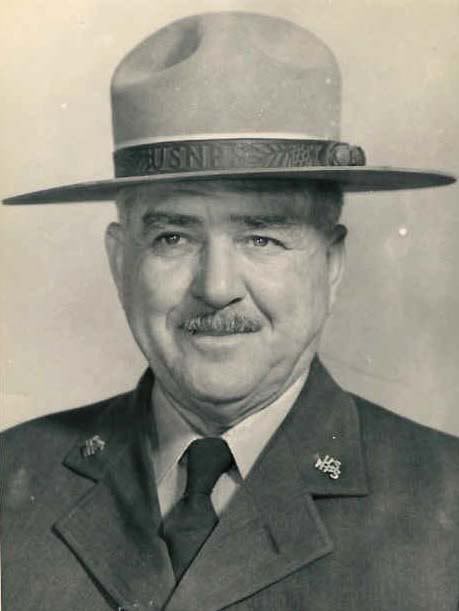 (established by presidential proclamation on October 25, 1923) and found, Custodian (an earlier name for superintendent) W.F. Mcilvain, who had been in charge for the three previous years. Mcilvain, who also served as the Director of the Carlsbad Chamber of Commerce from 1918 - 1934 (and worked in insurance and real estate), had succeeded Custodian Willis T. Lee, the eminent geologist of the early 1900s and United States Geological Survey who had taken leave from thatUSGS job to lead The National Geographic Society-sponsored six-month expedition (day trips only) of the caverns and natural features, caves and surface, in the adjacent area to the caverns in 1924. Dr. Lee's two 1925 Carlsbad Caverns articles in the NGS magazine articles served to attract additional nationwide attention to the previously obscure cave in southeastern New Mexico. Caverns photographer Ray Vesta Davis earlier had taken a number of caverns photographs that had illustrated a November 1923 New York Times article.
(established by presidential proclamation on October 25, 1923) and found, Custodian (an earlier name for superintendent) W.F. Mcilvain, who had been in charge for the three previous years. Mcilvain, who also served as the Director of the Carlsbad Chamber of Commerce from 1918 - 1934 (and worked in insurance and real estate), had succeeded Custodian Willis T. Lee, the eminent geologist of the early 1900s and United States Geological Survey who had taken leave from thatUSGS job to lead The National Geographic Society-sponsored six-month expedition (day trips only) of the caverns and natural features, caves and surface, in the adjacent area to the caverns in 1924. Dr. Lee's two 1925 Carlsbad Caverns articles in the NGS magazine articles served to attract additional nationwide attention to the previously obscure cave in southeastern New Mexico. Caverns photographer Ray Vesta Davis earlier had taken a number of caverns photographs that had illustrated a November 1923 New York Times article.
In 1926, prior to Tom Boles arriving, Custodian Mcilvain concerned himself with building trails, adequately lighting the cave, acquiring a telephone, building a power house, building on-site houses for guides, and,(one of his worse fears), building enough comfort stations. In 1925 with Carlsbad Chamber of Commerce funding and under the general supervision of Chief Guide Jim White, National Park Service employees constructed a 216-step stairway into the caverns Natural Entrance. This stairway marked the end of a colorful and "risky" era: people using the guano mining bucket to descend 170 feet into the caverns, and later to exit them.(The caverns had been mined for bat guano for use as a fertilizer for approximately 1903 - 1923.).
W.F. Mcilvain deserves our gratitude and appreciation. The challenges facing him during his three-year tenure (1924 – 1927) as the caverns boss always loomed larger than his small staff and available budget. Nevertheless, he accomplished much—getting a basic caverns trail, lighting, and comfort stations in place. He hired Jim White as the Chief Guide in 1925 and oversaw the completion of the caverns ticket office near the entrance. When he handed the cave responsibility over to Boles on May 15, 1927, this $1/month volunteer could do so with pride; he had improved much for the better at this 719.22 acre national monument. On March 9, 1928, almost ten months after Tom Boles took charge of the Carlsbad Cave National Monument, National Park Service Assistant Director A.E. Demaray told the Carlsbad Current-Argus "that the Park Service was going to make the Cavern the greatest show place in the world and that Colonel Tom Boles was the man chosen to do the job."
On March 9, 1928, almost ten months after Tom Boles took charge of the Carlsbad Cave National Monument, National Park Service Assistant Director A.E. Demaray told the Carlsbad Current-Argus "that the Park Service was going to make the Cavern the greatest show place in the world and that Colonel Tom Boles was the man chosen to do the job."
Clearly, in 1927, the cave monument faced incredibly difficult engineering projects in its short and long-term future ( in the caverns: cave lighting, trails, lunchroom facilities etc., and on the surface, buildings, roads, parking lots, paths etc.. Undoubtedly, Boles' engineering background would be an asset in those matters.
However, I believe that Superintendent Tom Boles' ability to promote the cave was the single strongest asset he brought to the job. To this job, he brought energy, enthusiasm, a "positive thinking" approach to life, and an "attention to details" philosophy to his job. I also believe that Boles was not a promoter in the P.T. Barnum showman sense of the term--a person willing to deceive others for the sake of money. Boles summed up a part of his philosophy in his July 1928 Superintendent Monthly Report when he said:
to promote the cave was the single strongest asset he brought to the job. To this job, he brought energy, enthusiasm, a "positive thinking" approach to life, and an "attention to details" philosophy to his job. I also believe that Boles was not a promoter in the P.T. Barnum showman sense of the term--a person willing to deceive others for the sake of money. Boles summed up a part of his philosophy in his July 1928 Superintendent Monthly Report when he said:
The liberal funds provided by the Appropriation Committee enable us to, not only protect our formations, but to handle visitors to best advantage. and will (It will) enable us to revise so that the trip can be made with about 60% of the effort formerly required, and this result, together with additional lighting, will insure more visitors and better appreciation of the most interesting and impressive features of our National Park System.
That Colonel Boles promoted additional visitation to Carlsbad Cave the historical record amply demonstrates. The first month in charge, he noted to his superior pleasure in finding out that the Santa Fe Railroad had printed and distributed 20,000 copies of folders containing caverns information. He said, the illustrations, as well as the text, make an excellent presentation of our attractions." Within seven months, the railroad company had distributed 40,000 more folders on the park.
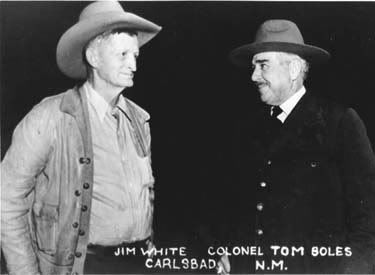 Boles also found satisfaction in an article by Mr. Carl Magee, editor of the New Mexico State Tribune in Albuquerque, and attached a copy to his monthly report. Magee wrote in the article:
Boles also found satisfaction in an article by Mr. Carl Magee, editor of the New Mexico State Tribune in Albuquerque, and attached a copy to his monthly report. Magee wrote in the article:The government has surveyed over 21 miles in those caves. The visitor must wait until Uncle Sam can spend the money to build the trails to make the added caverns accessible. But the three miles now open are sufficient to paralyze the eyes to see. The mind can absorb no more. (underline added)
In several monthly reports in 1927-1928, Boles lavished praise on the Carlsbad Chamber of Commerce's Mr. Victor Minter for his valuable cooperation with the Superintendent in obtaining favorable publicity for the Carlsbad Cave. Minter also answered information letters for potential visitors to the cave. In his monthly reports, more than once, Boles labeled the Chamber's efforts as examples of "hearty cooperation."
In September 1927, Boles reported that Metro-Golden-Mayer Co. photographed the bats in flight for a newsreel on September 30. On October 2, the newsreel company turned their cameras on visitors in the cave. In May of 1928, Metro-Golden-Mayer returned to film additional footage.
Also in September 1927, Superintendent Boles enjoyed the publicity the park received when the Santa Fe New Mexican wrote:
The United States Government has a lot of red tape, but it does some things well. Handling National Monuments is one of them. Two roomy stone-banked terraces are ready for your car; attendants direct you into line; there may be 100 cars ranked there. The parking is handled with expedition and care by the government employees. The National park and monument service, you see, has done its job well.
In December 1927 Boles pointed out that "Carlsbad Cavern was given due prominence in the El Paso Chamber of Commerce Tourist Booklet. He also enjoyed knowing that they had used one of his favorite photos in it, a shot showing 122 cars parked at the parking terrace. Boles added, "I know of no other one picture which so readily convinces a person that the Carlsbad Cave is a first class tourist attraction."
In January of 1928 a tour conductor of the Thomas Cook Tour Company visited. Boles said:
While this one was only a small party it was a very enthusiastic one and I believe a forerunner of much business from this same force. It is pleasing to this writer to find that the Carlsbad Cave is being recognized as a place worth while to visit by this International Tourist Agency.
The following month, Boles attended a Superintendent's Conference held in San Francisco and Yosemite National Park. Aside from the business of the meeting, he spoke on the cave to the Oakland Forum and arranged for park publicity through the magazines of the Los Angeles Chamber of Commerce, the Southern Pacific Co., the Pacific Electric Railway, as well as other companies.
In June of 1928, Boles went to Fort Worth, Texas to attend a meeting of the West Texas Chamber of Commerce, 3000 delegates strong. Of the several New Mexico delegates attending, Boles was the only delegate to have assigned a place on the program; he presented a 30-minute program describing Carlsbad Cave. Two days later, he presented a ten-minute broadcast on Fort Worth radio station WBAP.
In July, he noted that the Cavern Transportation Co. had issued some 25,000-cavern folders. In the same report, Boles added, "Our best travel producer is the satisfied tourist, who, upon his return, finds himself unable to describe his trip through the cavern, and urges his friends to make the trip for themselves."
Boles also acknowledged that children had a role in spreading the word about the limestone cave in southeastern New Mexico. In August 1928, he noted, "I really believe that children's return to their schools this fall will be our most active agents of publicity in their communities."
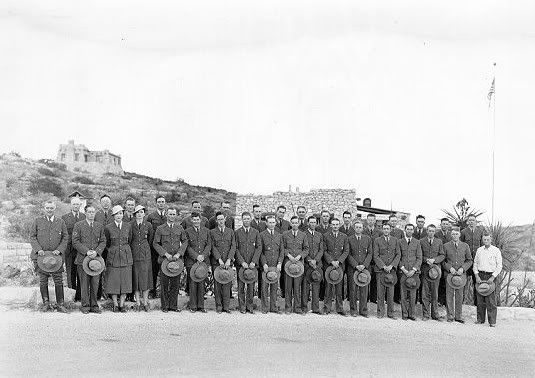 It is easy to realize that Boles spent a good deal of time on the road publicizing the park. Moreover, the subject of tributary roads condition, tributary roads being those leading to the park, occupied much of Boles attention. Boles noted in the May 1927 report that, "the frequent dust whirlwinds are annoying at times to auto travel." In June, he noted, "the thirty-mile highway between Carlsbad and the Cavern has suffered considerably from the combined heavy traffic and the hot weather...The predicted rains which would mean so much to us now have failed to materialize."
It is easy to realize that Boles spent a good deal of time on the road publicizing the park. Moreover, the subject of tributary roads condition, tributary roads being those leading to the park, occupied much of Boles attention. Boles noted in the May 1927 report that, "the frequent dust whirlwinds are annoying at times to auto travel." In June, he noted, "the thirty-mile highway between Carlsbad and the Cavern has suffered considerably from the combined heavy traffic and the hot weather...The predicted rains which would mean so much to us now have failed to materialize."Rain would cool the air and reduce the dust. In July, over 400 boosters of the DAL-PASO highway, a highway from the Fort Worth area to El Paso, visited. Boles remarked, "it is very satisfying to note how enthusiastic these visitors are over the cavern and how appreciative they were over the attention and courtesies given them by the National Park Service."
In August, on the subject of roads, Boles continued:
The forces of the State Highway Commission have been working all this month improving the road between the Cavern and the Texas State line, a distance of about eighteen miles over which considerable traffic has been coming during the past month. About half of this is now finished and satisfactory progress is being made on the balance, which, when completed, will give us a road to El Paso ninety miles shorter than the road usually taken.
That work was completed in September 1927.
Boles also took interest in surfacing being placed on the entrance road in September 1927, in the $950,000 El Paso Road bond passed in December, and in the local Chamber of Commerce's interest in hard surfacing the twenty miles between Carlsbad and the Cavern in January 1928. Boles stayed informed on road issues and lent his influence on the subject where he could.
Obviously, Boles realized the value of the twin effort of good publicity and good roads in increasing visitation to the cavern. He realized the value of satisfied customers returning to their home and urging their friends and relatives to see the cave for themselves. Boles took pride in the large crowds, the new visitation records, the famous visitors, and the photographs, which documented these activities. Nevertheless, the Colonel was not, in my opinion, satisfied with just the large crowds. He wanted the visitors to enjoy themselves, to appreciate the wonderful cave, to protect it. Boles promoted visitation, but he also promoted quality experiences. He was not satisfied with visitor numbers; he wanted his visitors to be glad that they had come to the cave.
Some examples of Boles' efforts on caverns protection: as early as July 1927, he was giving 5-10 minute talks at the natural entrance to groups going in, covering a trip outline, cave history, cave geology, and a special stress on care and preservation of the formations along the route. In August 1927, Boles wrote:
Although Lower Chamber can now be reached over ladders, it is best to keep the general public out until trails can be constructed therein and guard rails placed around the more delicate formations, as under the present condition it would be practically impossible and difficult to prevent vandalism in the Lower Chamber.
The same month Boles, referring to guide fee receipts, wrote, "...new receipts have the rules and regulations brief therein. I believe that it will tend to discourage vandalism and souvenir collection which has at times been so troublesome during the postseason."
Later in October, he wrote about the Metro-Golden-Mayer newsreel-filming project and remarked, "I believe this will give the cavern wide-spread publicity, but during the filming of the underground scenes I will see that our formations are properly protected at all time and that nothing is damaged."
When discussions in 1928 began about the possibility of constructing a utility shaft in the cavern (a project that later developed into a full size passenger elevator), Boles insisted that the National Park Service pay fully for it and keep full control. The always-thinking superintendent wanted full authority to close the planned shaft should it prove detrimental to the cave.
Boles strongly advocated caverns preservation. Occasionally, a story arises that Boles had a bucket of cave pearls on his desk for handing out as gifts. I have never seen documentation proving this assertion. At this point, Boles' efforts at protection and preservation make such documentation seem unlikely to me. In May 1928, Boles even got involved in stopping Chicago “cactus pirates” who were denuding parts of Walnut Canyon, at that time not yet part of the park. He even called the General Land Office in Washington D.C. for help.
Publicity, preservation, and roads were but a few of the projects that Tom Boles worked on in 1927-28. The very important Cavern Supply Company began; the serving of lunches in the caverns began in the caverns (my research indicates that not only did the lunchroom provides a place for visitors to eat, but it was a planned strategy to try to keep litter in one main part of the caverns where it could be collected. Trails were modified and improved, as were lights. The "Bat Flight" and "Rock of Ages" programs began.
By 1929, the caverns received 90,000 visitors per year. Under Boles supervision, many important park events lay ahead. On May 14, 1930, Carlsbad Cave National Monument became Carlsbad Caverns National Park. In the ensuing decade ahead, a high-speed elevator in a 750-foot shaft would replace the 216-steps stairway at the natural entrance. In the early 1930s,
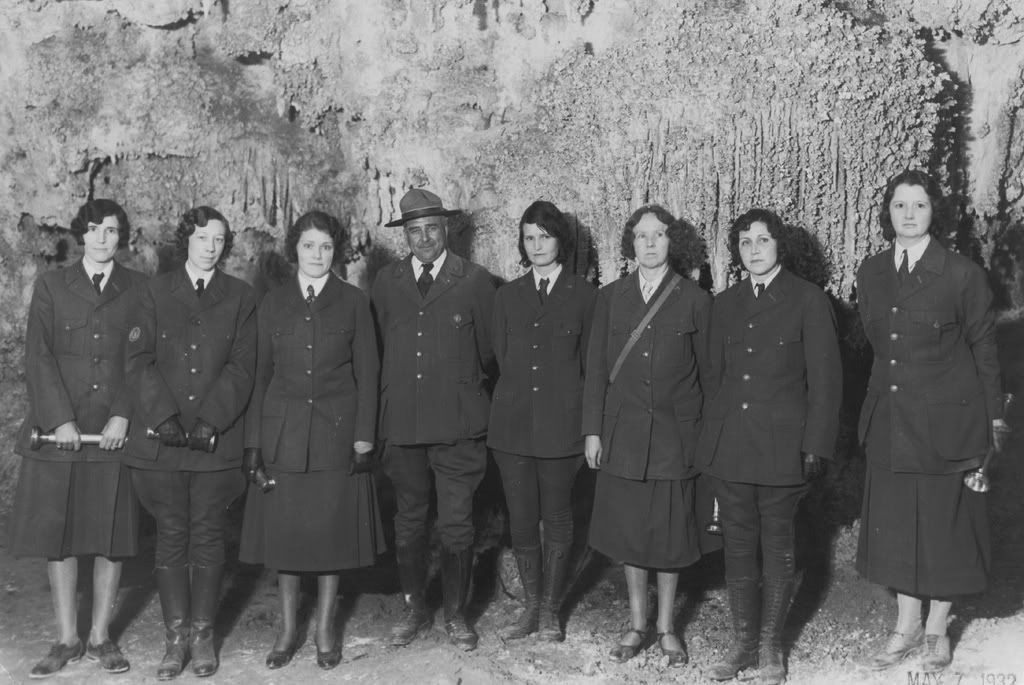 explorers would discover the deepest point in the caverns, The Lake of the Clouds. In the middle 1930s, the park would obtain Rattlesnake Springs, a detached section of land, as the park water supply (in 1963 Rattlesnake Springs would be added to Carlsbad Caverns National Park).
explorers would discover the deepest point in the caverns, The Lake of the Clouds. In the middle 1930s, the park would obtain Rattlesnake Springs, a detached section of land, as the park water supply (in 1963 Rattlesnake Springs would be added to Carlsbad Caverns National Park). In February 1939, 39,000+ acres of land (land that included Slaughter Canyon Cave) were added to the park’s land resources.
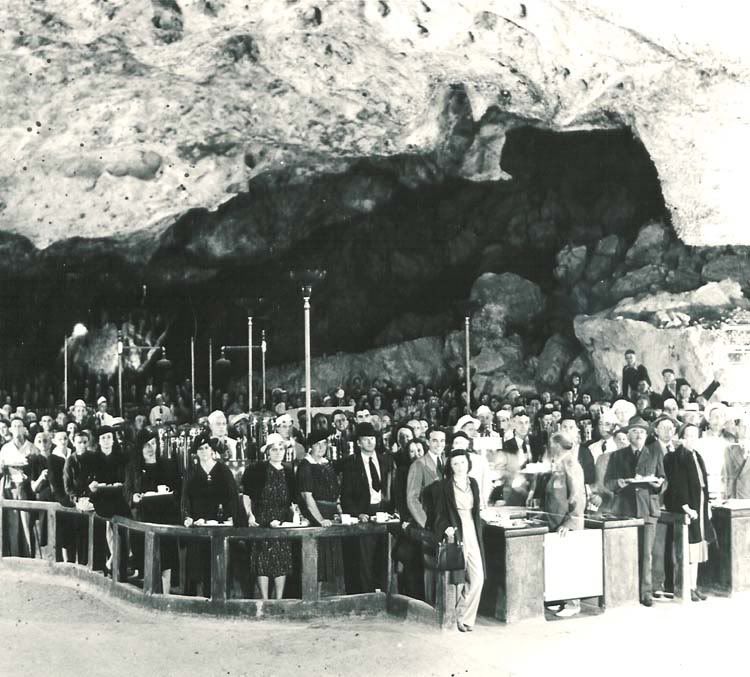 In later years, one of Boles' favorite park programs--the Rock of Ages ceremony-- came under fire from some of his higher-ups.The program started on July 27, 1928 after a noted American baritone, Cameron McClean, visited the caverns and sang “Rock of Ages” to express his feelings about the cave (Carlsbad Current Argus, 12/3/95). For the next 17 years, with visitors gathered at this famous formation in the Big Room. There a talk would be given by NPSstaff(often Boles himself, the Big Room lights would be turned out, and the song Rock of Ages would be sung by rangers or a visiting choral group, or played on a phonograph player.
In later years, one of Boles' favorite park programs--the Rock of Ages ceremony-- came under fire from some of his higher-ups.The program started on July 27, 1928 after a noted American baritone, Cameron McClean, visited the caverns and sang “Rock of Ages” to express his feelings about the cave (Carlsbad Current Argus, 12/3/95). For the next 17 years, with visitors gathered at this famous formation in the Big Room. There a talk would be given by NPSstaff(often Boles himself, the Big Room lights would be turned out, and the song Rock of Ages would be sung by rangers or a visiting choral group, or played on a phonograph player.Some of Boles National Park Service and other“higher-ups” did not like this ceremony (probably because they felt the program lacked the necessary “dignity” for a national park program. Over a short course of time, Boles was ordered to cancel the program on several occasions. He refused to do so. On December 5, 1944, the program ceased; for the next ten years, the lack of the Rock of Agesprogram became the visitors #1 complaint.
Boles resistance to his bosses--on behalf of what he felt was the issue of retaining a quality park program for the visitors-- cost him his job at the caverns. In 1946, the NPS transferred him to Hot Springs National Park in Arkansas where he served as the superintendent from June 8, 1946 until April 1, 1951.
Boles returned to Carlsbad in 1955 and went to work for a local potash company. In 1964, at the age of 83, Boles did a Rock of Ages re-enactment speech at the high school. Mr. Pete Trone, who conducted an oral history interview with me in May 1994, said that Boles "mesmerized his audience."
Ray V. Davis, the well-known caverns photographer, said, "Col. Tom was an ardent booster of the Cavern and made many speeches around the country. His speeches always went over big because they were short, snappy, and witty and always boosting the cavern."
Mrs. Olive Johnson, who was hired as a nurse-guide by Tom Boles in 1943, and who went on to a career of over thirty years at Carlsbad Cavern, told me in an interview that she never met anyone who cared about the Cavern as much as Tom Boles did. (Note: Mrs. Johnson was my first permanent supervisor when I became a permanent park guide at the caverns in June 1971; she passed away in April 2006.).
As I stood at Mr. Boles grave site this past Saturday (in February 1996--nine years before I retired in Febraury 2005), I noticed that his wife Jimmie Boles preceded him in death in 1962 at the age of 69. Tom Boles, the man that some newspapers called "Mr. Carlsbad Caverns" and "King of the Underworld," died at the age of 92 in 1973.
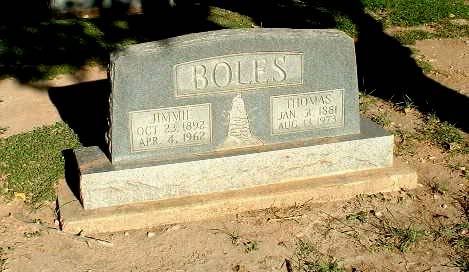 At the Carlsbad cemetery on their gravestone between the names of Boles and his wife is an engraved stalagmite.
At the Carlsbad cemetery on their gravestone between the names of Boles and his wife is an engraved stalagmite. Even in death, Colonel Boles is indirectly promoting the caverns.
Note: The three paragraphs in the beginning of this post that deal with facts about Bole's early life are directly taken from Carlsbad Caverns The Early Years A Photographic History of the Caverns and Its People by Robert Nymeyer and William Halliday.
9 comments:
For hottest information you have to pay a quick visit world wide web and on world-wide-web I found this site as a best website
for newest updates.
Feel free to surf to my site :: wiki.zbedu.net
Hi to all, how is the whole thing, I think every one is getting more from this web page,
and your views are good in favor of new people.
Here is my weblog; How to get rid of stretch marks
Hi there, all is going fine here and ofcourse every one is sharing facts, that's really fine, keep up writing.
Here is my blog ... stretch mark lotion
Spot on with this write-up, I really believe this amazing site needs far more attention.
I'll probably be back again to see more, thanks for the information!
my web page apeter.com
Thanks for sharing your info. I really appreciate your efforts and
I am waiting for your further post thank you once again.
my blog - http://wiki.owars.de
ecig, e cigarette reviews, smokeless cigarettes, e cig, electronic cigarette, e cigarette
smokeless cigarette, ecig forum, electronic cigarette brands, e cigarette reviews, electronic cigarettes, e cigarettes
supreme clothing
supreme outlet
off white hoodie
yeezy 500
nike off white
golden goose shoes
nike react
yeezy
supreme sweatshirt
goyard wallet
bags replica gucci f64 x2k07u0l32 luxury replica bags u31 a5b87o5z01 Louis Vuitton replica Bags d12 e3t63r5b50
Post a Comment